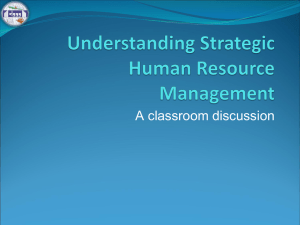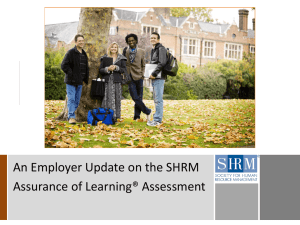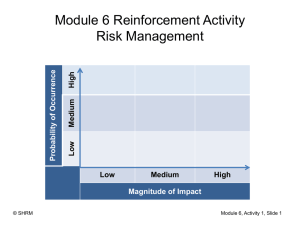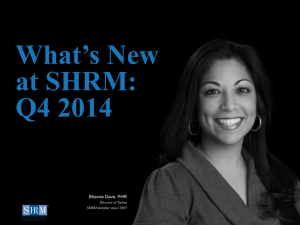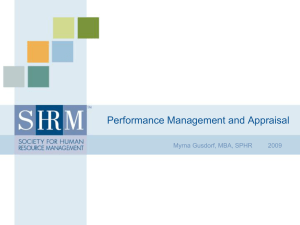Module 6
advertisement
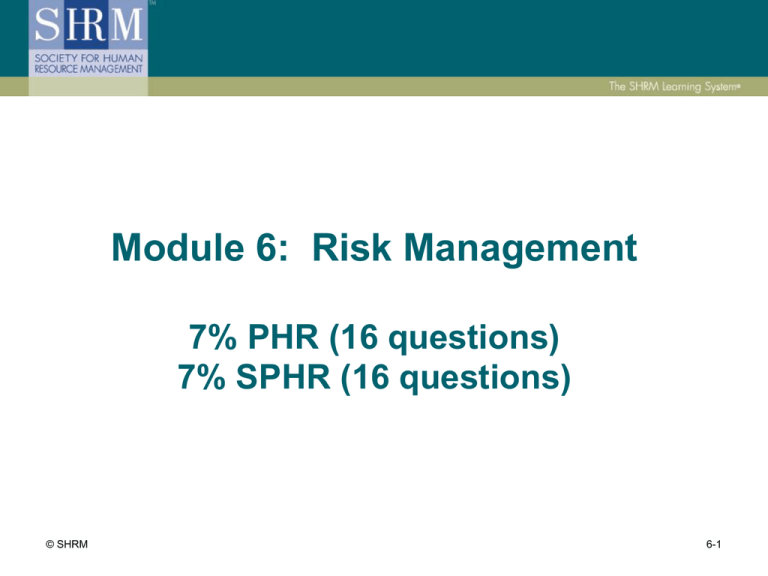
Module 6: Risk Management 7% PHR (16 questions) 7% SPHR (16 questions) © SHRM 6-1 Categories of Operational Risk • • • • • Personnel risk (fraud and error) Physical assets (business environments) Technology (viruses) Relationships (lawsuits) External/regulatory (external fraud) HR role: Examine HR policies to prevent or mitigate loss and ensure business continuity. © SHRM 6-2 Risk Management Techniques Assess risk Develop systems Evaluate/modify systems Implement programs Monitor efforts Tools: Enterprise risk management (ERM) software systems and risk management scorecard © SHRM 6-3 Continuity and Recovery Business continuity planning • Identifies potential threats and impacts. • Plans for disruption, interruption, or loss of business functions. Disaster recovery planning • A set of guidelines to be used for recovery of data. © SHRM 6-4 Insurance That Mitigates Risk • Employment practices liability insurance (EPLI) – Protects against claims of discrimination, wrongful termination, or sexual harassment. • Errors and omissions (E&O) insurance – Protects against employment claims; covers economic and emotional damages. • Directors’ and officers’ (D&O) liability insurance – Protects directors, officers, and the corporation from claims related to SEC violations or shareholder class actions. © SHRM 6-5 Risk Management Legislation: OSHA Employee rights Employees must comply with OSHA standards and have a right to: • Demand safety and health on the job. • Request inspections. • Have an authorized representative accompany an inspection. • File a complaint. • Be informed of workplace hazards. • Receive training. © SHRM 6-6 Risk Management Legislation: OSHA Employer responsibilities Keep employees informed. Keep employees safe. • Display OSHA posters. • Provide copies of rules and regulations. • Post OSHA citations. • Maintain accurate records. • Permit authorized employee representation during an OSHA inspection. • Correct violations. • Allow employees to refuse abnormally dangerous work. • Provide personal protective equipment. • Provide medical surveillance. • Provide training. • Enforce rules and regulations. © SHRM 6-7 Which of the following is an example of an employer’s rights under OSHA? A. To apply to OSHA for a temporary or permanent variance from a standard B. To appoint an employee representative to accompany OSHA during inspections C. To refrain from enforcing rules that cause economic hardship for the company D. To review and rule on employee protests regarding unsafe working conditions Answer: A © SHRM 6-8 OSHA Regulatory Standards • Emergency Exit Procedures • Occupational Noise Exposure • Machine Guarding • Hazard Communication • Control of Hazardous Energy—Lockout/Tagout © SHRM • Bloodborne Pathogens • Confined Space Entry • Personal Protective Equipment • Process Safety Management 6-9 Injury and Illness Definitions PHR only • Occupational injury: Injury that results from a work-related accident or exposure involving a single incident. • Occupational illness: Medical condition or disorder caused by exposure to environmental factors associated with employment. © SHRM 6-10 Recording Criteria PHR only For both work-related illnesses and injuries: • Death • Days away from work • Restricted work or transfer to another job • Loss of consciousness • Diagnosis by a licensed health-care professional • Medical treatment beyond first aid © SHRM 6-11 PHR only An employer learns that a worker has fractured an arm on the job. Within what time frame must the employer complete OSHA Form 300? A. B. C. D. 3 working days 7 working days 8 hours 24 hours Answer: B © SHRM 6-12 OSHA Inspection Priorities 1. • Imminent danger 2. • Catastrophes and fatal accidents 3. • Employee complaints 4. • High-hazard industries 5. • Follow-up inspections © SHRM 6-13 OSHA Violations Willful • Intentional Serious • Likely to cause death or serious injury Other-thanserious Repeat De minimus © SHRM • Not likely to cause death or serious injury • Repeat of an earlier violation • No direct or immediate relationship to job safety or health 6-14 Drug-Free Workplace Act Federal contractors with contracts of $100,000 or more must: • Develop a policy that maintains a drug-free workplace. • Specify penalties for policy violations. • Provide a copy of the policy to employees. • Establish a drug-awareness program. © SHRM 6-15 Safety Hierarchy © SHRM Priority 1 • Eliminate hazard. Priority 2 • Use safeguards. Priority 3 • Use warning signs. Priority 4 • Train and instruct. Priority 5 • Provide personal protection. 6-16 Safety Responsibilities HR Gain management support. Assist in coordinating safety programs. Develop reporting system. Provide expertise on accident research and prevention. Train line managers. © SHRM Line Management Show support of safety. Monitor employees. Recognize hazards. Report accidents and conduct follow-up actions. Follow up with employees. ACCEPT ULTIMATE RESPONSIBILITY FOR SAFETY. 6-17 Safety Committees • • • • Are elected by peers. Encourage safety awareness. Motivate employees. Identify and correct hazards. Ensure that the safety committee does not become an employer-dominated labor organization—a violation of the NLRA. © SHRM 6-18 Influences on Accidents & Incidents Internal Factors • Nature of task • Work group • Management goals • Organizational style • Leader’s style and experience • Employee orientation • Machinery © SHRM External Factors • Economic and geographic conditions • Labor force mix • Labor unions • Governmental regulations Human Factors • Attitudes, abilities, motivation, and preferences • Skills • Distractions 6-19 Classifying Incidents • Failing to use protective equipment • Improper dress or use of equipment • Performing unauthorized procedures Unsafe acts © SHRM • • • • • Defective equipment Noise, heat, dust, or vibration Poor ventilation Improper lighting Unsafe floor surfaces Unsafe conditions 6-20 Accident Prevention • Design work sites and flow to manage risk. • Assign safety specialists and line managers to committees. • Analyze why accidents happen and have outside experts inspect working conditions. • Provide updated job and safety training; test and document results. • Provide safety rewards and recognition. © SHRM 6-21 Ergonomics Programs © SHRM Include: • • • • • • • Ergonomics team Work-site analysis Job redesign Surveys/monitoring/feedback Training On-site exercise programs Budget Reduce: • • • • Musculoskeletal disorders Computer vision syndrome Lower back strains Sick building syndrome 6-22 Modified-duty programs require that injured employees A. return to less-strenuous jobs on a permanent basis. B. refrain from taking FMLA leave until they can return to work. C. stay on disability until they can perform all the duties of their current jobs. D. perform jobs that accommodate their current limitations. Answer: D © SHRM 6-23 Health Hazards Infectious diseases • Current illnesses – – – – © SHRM Hepatitis B virus Hepatitis C virus HIV/AIDS Tuberculosis • Future pandemics – Disease that is new to the population – Human infection that causes serious illness – Agent that spreads easily 6-24 Health Hazards Environmental factors • Physical – Heat, noise, air conditioning, radiation, ventilation, smoking, sanitary conditions, drinking water, etc. • Chemical – Dust, fumes, gases, toxic materials and chemicals, carcinogens, smoke • Biological – Bacteria, fungi, insects © SHRM 6-25 Employee Assistance Programs Services provided: • Financial • Workplace violence • Career • Legal • Family and marital • Alcohol and drug abuse • Emotional © SHRM EAP options: • In-house • Outside contractors • Consortium • Affiliate 6-26 Employee Wellness Programs Nutrition and weight control © SHRM Smoking cessation Stress reduction Wellness and fitness 6-27 A written policy on substance abuse benefits the organization because A. it’s a deterrent to absenteeism and tardiness. B. supervisors are more willing to confront employees with impaired performance. C. it fulfills compliance with state and local laws and ordinances. D. top management does not have to deal with issues related to drug abuse. Answer: B © SHRM 6-28 Drug Testing Categories Preemployment Reasonable suspicion and for cause Post-accident Post-treatment Random Periodic © SHRM 6-29 Drug Intervention Strategies © SHRM Constructive confrontation • Focuses on job performance Counseling • Focuses on the cause of the problem 6-30 Security Measures • Security guards • Preventive audits • Identification and external control systems • Fingerprints, magnetic cards • Structural barriers • Gates, fences • Security hardware • Alarms, sensors © SHRM 6-31 Fraud Control Practices • • • • • Inventory counts Fraud hotlines Sound auditing procedures Video surveillance Dollar-limit authority © SHRM 6-32 Risk Analysis Vulnerability = Degree of probability that loss will occur + Severity of impact Probability • Virtually certain • Highly probable • Moderately probable • Improbable © SHRM Severity • • • • Fatal Very serious Moderately serious Negligible 6-33 Emergency Response Plan Guidelines • • • • • • • Involve senior management. Create a team. Set priorities. Identify resources. Communicate the plan. Keep the plan up-to-date. Test the plan. © SHRM 6-34 Causes of Workplace Violence Violence = Stress + Inappropriate responses + Opportunity • Reduce stress by giving employees a vehicle to express concerns. • Reduce inappropriate responses by checking employee references and monitoring behavior. • Reduce opportunity by maintaining a zero tolerance policy for weapons and violence. © SHRM 6-35 Government Responses to Terrorism • USA PATRIOT Act – Expands powers of the government to deal with suspected terrorists or those harboring them. • Department of Homeland Security – Creates a National Response Plan to manage domestic incidents. – Analyzes threats and intelligence. – Guards borders and airports; protects infrastructure. © SHRM 6-36 Protection of Proprietary Information • Restrict access to computer information and employee data. • Restrict discussion or display of sensitive information. • Ask employees to safeguard company secrets. • Use confidentiality and nondisclosure agreements. • Identify proprietary information. © SHRM 6-37
